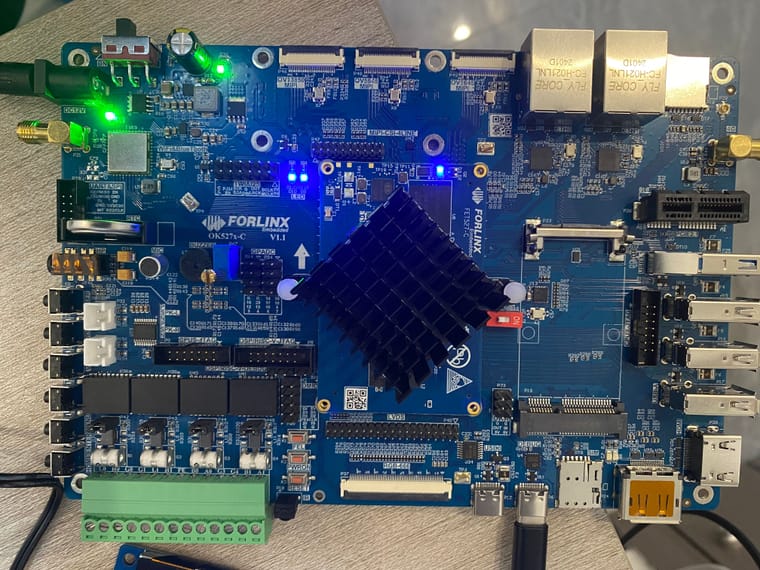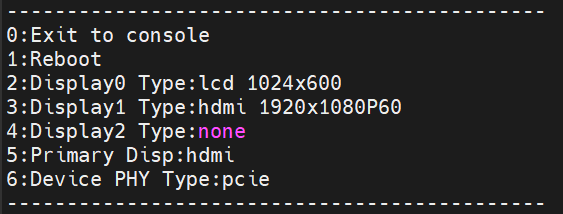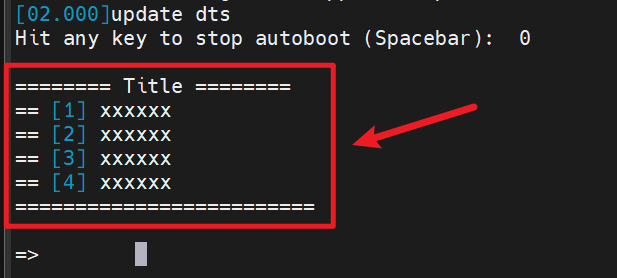飞凌OKT527开发板U-Boot添加自定义菜单
-
昨日,终于收到了心心念念的飞凌OK-T527开发板,板子很漂亮,外设丰富,性能强悍,T527创新性地使用了RISC-V架构的协处理器,后期值得研究一下异核的使用:

有趣的是,板子上电,按任意键进入U-Boot会自动列出一个功能菜单,有切换屏幕等功能:

基于此,本文将分析如何在U-Boot添加自定义菜单。一、实验环境介绍
硬件:飞凌OK-T527开发板
软件:全志Longan SDK(U-Boot版本2018)
说明:本次实验不限制平台,请参考实际情况阅读。二、目标
本文主要分析U-Boot在程序中的执行顺序,又如何在U-Boot阶段调起菜单?相信大家都试过,在U-Boot倒数结束前按任意按键后,会进入U-Boot命令行模式。
这里先留一个问题:如何做到按键按下后,调启的是自己的U-Boot菜单,而不再是进入命令行模式?三、U-Boot如何自动调起菜单
U-Boot的入口程序文件是 <u-boot>/common/main.c,入口函数main_loop():/* <u-boot>/common/main.c */ ... /* We come here after U-Boot is initialised and ready to process commands */ /* 在U-Boot初始化并准备好处理命令之后,我们来到这里。 */ void main_loop(void) { const char *s; bootstage_mark_name(BOOTSTAGE_ID_MAIN_LOOP, "main_loop"); #ifdef CONFIG_VERSION_VARIABLE env_set("ver", version_string); /* set version variable */ #endif /* CONFIG_VERSION_VARIABLE */ cli_init(); //命令初始化有关,初始化 hush shell 相关的变量 run_preboot_environment_command(); //获取环境变量 perboot 的内容 #if defined(CONFIG_UPDATE_TFTP) update_tftp(0UL, NULL, NULL); #endif /* CONFIG_UPDATE_TFTP */ s = bootdelay_process(); //此函数会读取环境变量 bootdelay 和 bootcmd 的内容 if (cli_process_fdt(&s)) cli_secure_boot_cmd(s); autoboot_command(s); //开启倒计时,并在倒计时结束前检测是否有按键按下 cli_loop(); //命令行处理函数(即进入U-Boot命令行) panic("No CLI available"); }关键函数是autoboot_command(),该函数的实现在 <u-boot>/common/autoboot.c:
/* <u-boot>/common/autoboot.c */ ... void autoboot_command(const char *s) { debug("### main_loop: bootcmd=\"%s\"\n", s ? s : "<UNDEFINED>"); if (stored_bootdelay != -1 && s && !abortboot(stored_bootdelay)) { // 倒计时过程中,没有按键按下 #if defined(CONFIG_AUTOBOOT_KEYED) && !defined(CONFIG_AUTOBOOT_KEYED_CTRLC) int prev = disable_ctrlc(1); /* disable Control C checking */ #endif run_command_list(s, -1, 0); // 倒计时结束后,启动内核 #if defined(CONFIG_AUTOBOOT_KEYED) && !defined(CONFIG_AUTOBOOT_KEYED_CTRLC) disable_ctrlc(prev); /* restore Control C checking */ #endif } #ifdef CONFIG_MENUKEY if (menukey == CONFIG_MENUKEY) { s = env_get("menucmd"); if (s) run_command_list(s, -1, 0); } #endif /* CONFIG_MENUKEY */ }进入 autoboot_command() 后,先看第一个if:
void autoboot_command(const char *s) { ... if (stored_bootdelay != -1 && s && !abortboot(stored_bootdelay)) ... }这里有三个条件:
● stored_bootdelay != -1:stored_bootdelay是倒数的总时间,就是常见的3秒、5秒不等;
● s:传进来的参数s不能为空;
● !abortboot(stored_bootdelay):该函数会从stored_bootdelay开始倒计时,期间判断是否有按键按下。函数实现如下,倒计时过程中若检测到按键按下,则令abort=1。无按键按下,则abort=0。最后返回abort。/* <u-boot>/common/autoboot.c */ ... static int __abortboot(int bootdelay) { int abort = 0; unsigned long ts; #ifdef CONFIG_MENUPROMPT printf(CONFIG_MENUPROMPT); #else printf("Hit any key to stop autoboot: %2d ", bootdelay); #endif /* * Check if key already pressed */ if (tstc()) { /* we got a key press */ (void) getc(); /* consume input */ puts("\b\b\b 0"); abort = 1; /* don't auto boot */ } while ((bootdelay > 0) && (!abort)) { --bootdelay; /* delay 1000 ms */ ts = get_timer(0); do { if (tstc()) { /* we got a key press */ abort = 1; /* don't auto boot */ bootdelay = 0; /* no more delay */ # ifdef CONFIG_MENUKEY menukey = getc(); # else (void) getc(); /* consume input */ # endif break; } udelay(10000); } while (!abort && get_timer(ts) < 1000); printf("\b\b\b%2d ", bootdelay); } putc('\n'); return abort; } ...刚刚说了,abortboot() 函数执行期间有按键按下的话,abortboot() 会返回1,那就不会进入第一个if,程序会接着往下运行直至该函数运行结束。autoboot_command() 结束后继续返回到main_loop(),随后立刻执行cli_loop(),进入我们所熟悉的U-Boot命令行模式。

至此,就实现了U-Boot倒数期间,有按键按下,则进入U-Boot的命令行模式。
现在继续回到第一个if:/* <u-boot>/common/autoboot.c */ void autoboot_command(const char *s) { ... if (stored_bootdelay != -1 && s && !abortboot(stored_bootdelay)) { // 倒计时过程中,没有按键按下 #if defined(CONFIG_AUTOBOOT_KEYED) && !defined(CONFIG_AUTOBOOT_KEYED_CTRLC) int prev = disable_ctrlc(1); /* disable Control C checking */ #endif run_command_list(s, -1, 0); // 倒计时结束后,启动内核 #if defined(CONFIG_AUTOBOOT_KEYED) && !defined(CONFIG_AUTOBOOT_KEYED_CTRLC) disable_ctrlc(prev); /* restore Control C checking */ #endif } ... }如果在autoboot倒计时结束前,一直没有按键按下呢?那 abortboot() 最后会返回0,第一个if的三个条件全部满足。进入if,run_command_list() 执行一系列命令后,启动内核。注意,这里的现象是直接启动内核,run_command_list() 后的程序不再执行。
解析到这里,我们得出一个结论:在autoboot倒计时中,如果有按键按下的话,会进入U-Boot的命令行模式。无按键按下则在倒计时结束后直接启动内核。
那现在可以回答第一个问题,如何做到按下按键后,是自启动U-Boot菜单,而不是进入U-Boot命令行呢?答案是在执行cli_loop()之前,我们可以在autoboot检测到按键按下后,调用run_command()函数执行menu命令,从而调起菜单。void autoboot_command(const char *s) { debug("### main_loop: bootcmd=\"%s\"\n", s ? s : "<UNDEFINED>"); if (stored_bootdelay != -1 && s && !abortboot(stored_bootdelay)) { #if defined(CONFIG_AUTOBOOT_KEYED) && !defined(CONFIG_AUTOBOOT_KEYED_CTRLC) int prev = disable_ctrlc(1); /* disable Control C checking */ #endif run_command_list(s, -1, 0); #if defined(CONFIG_AUTOBOOT_KEYED) && !defined(CONFIG_AUTOBOOT_KEYED_CTRLC) disable_ctrlc(prev); /* restore Control C checking */ #endif } //在此处启动菜单 run_command("menu", 0); #ifdef CONFIG_MENUKEY if (menukey == CONFIG_MENUKEY) { s = env_get("menucmd"); if (s) run_command_list(s, -1, 0); } #endif /* CONFIG_MENUKEY */ }四、U-Boot添加自定义命令
难道通过 run_command() 执行menu命令后,菜单就自己出来了?这是一个理所当然的猜想。实际上U-Boot根本不认识menu命令:

接下来看看如何添加U-Boot命令,参考一下别人的代码:/* <u-boot>/board/BuS/eb_cpu5282/eb_cpu5282.c */ int do_brightness(cmd_tbl_t *cmdtp, int flag, int argc, char * const argv[]) { int rcode = 0; ulong side; ulong bright; switch (argc) { case 3: side = simple_strtoul(argv[1], NULL, 10); bright = simple_strtoul(argv[2], NULL, 10); if ((side >= 0) && (side <= 3) && (bright >= 0) && (bright <= 1000)) { vcxk_setbrightness(side, bright); rcode = 0; } else { printf("parameters out of range\n"); printf("Usage:\n%s\n", cmdtp->usage); rcode = 1; } break; default: printf("Usage:\n%s\n", cmdtp->usage); rcode = 1; break; } return rcode; } U_BOOT_CMD( bright, 3, 0, do_brightness, "here is uboot mymenu\n", "here is uboot mymenu, make in 2024-05-15\n" );先看最底下的U_BOOT_CMD,这是一个宏,用来添加U-Boot命令:
/* <u-boot>/include/command.h */ #define U_BOOT_CMD(_name, _maxargs, _rep, _cmd, _usage, _help) \ U_BOOT_CMD_COMPLETE(_name, _maxargs, _rep, _cmd, _usage, _help, NULL)● _name:命令的名字
● _maxargs:添加的命令最多有几个参数
● _rep:是否重复(1重复,0不重复),指在U-Boot命令行按下Enter键的时候,重复执行上次的命令
● _cmd:执行函数(即执行该命令后,运行哪个函数)
● _usage:短帮助信息
● _help:长帮助信息再来看看执行函数do_brightness的声名:
int (*cmd)(struct cmd_tbl_s *cmdtp, int flag, int argc, char *const argv[]);● cmdtp:Table entry describing the command (see above).
● flag:A bitmap which may contain the following bit
○ CMD_FLAG_REPEAT - The last command is repeated.
○ CMD_FLAG_BOOTD - The command is called by the bootd command.
○ CMD_FLAG_ENV - The command is called by the run command.
● argc:执行命令时,传入的参数数量
● argv:传入的参数五、实践
下面,添加一个U-Boot菜单,不过只作打印,没有实际功能。
在 <u-boot>/drivers 下创建一个名为mymenu的文件夹:

在mymenu文件夹下创建mymenu.c,内容如下:#include <common.h> #include <command.h> #include <linux/ctype.h> #include <cli.h> #include <fs.h> static int do_mymenu(struct cmd_tbl_s *cmdtp, int flag, int argc, char *const argv[]) { printf("\n======== Title ========\n"); printf("== [1] xxxxxx\n"); printf("== [2] xxxxxx\n"); printf("== [3] xxxxxx\n"); printf("== [4] xxxxxx\n"); printf("=========================\n\n"); return 0; } U_BOOT_CMD( menu, 1, 1, do_mymenu, "here is uboot menu\n", "here is uboot menu, make in 2024-06-27\n" );还需在mymenu文件夹下创建一个Makefile文件,内容如下:
obj-y += mymenu.o最后修改 <u-boot>/drivers/ 下的Makefile,在结尾加上如下内容,表示要编译mymenu路径下的文件:
ifeq ($(CONFIG_SPL_BUILD)$(CONFIG_TPL_BUILD),) obj-y += mymenu/ endif
编译U-Boot,更新U-Boot,重启单板,在U-Boot倒计时结束前,按任意按键就进入我们自定义的菜单:

剩下的菜单程序编写就是根据实际功能来开发了。六、总结
若有描述错误欢迎指出。
Copyright © 2024 深圳全志在线有限公司 粤ICP备2021084185号 粤公网安备44030502007680号